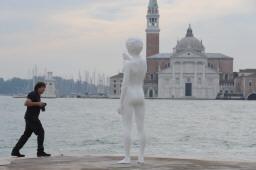Venice took another step towards establishing itself as a European mecca for modern and contemporary art on Wednesday with the inauguration of two new venues.
Thanks to the Biennale art exhibition and the Peggy Guggenheim Collection, Venice has for years been seen as an obligatory destination for contemporary art lovers.
Now the Punta della Dogana, which will provide a semi-permanent home for works from the collection of French billionaire François Pinault, and the Museo Vedova, dedicated to the late Venetian abstract art pioneer Emilio Vedova, will add to the lagoon city's art appeal.
A former 17th-century coach house just over the water from St Mark's Square, the Punta della Dogana will act as a second venue alongside Palazzo Grassi for an upcoming exhibition, entitled Mapping The Studio, which opens to the public on Saturday.
On show will be around 250 of the 2,500 works Pinault has acquired since 1971 by artists including Jeff Koons, Sigmar Polke, Cindy Sherman, Maurizio Cattelan and Adel Abdessemed.
''This is an extraordinary site,'' said Pinault, whose empire includes Christie's, Gucci and Yves Saint Laurent.
''I wanted to make this space a cultural centre from the very first time I saw it''.
Japanese architect Tadao Ando spent a year and a half overhauling the interior of the customs house, with the work costing some 20 million euros.
Venice Mayor Massimo Cacciari, who attended Wednesday's inauguration along with Pinault and Ando, described the Japanese architect's work as ''masterful''.
On Wednesday Pinault also uncovered a monumental statue, entitled Boy With Frog, by American artist Charles Ray, which will stand outside the Punta della Dogana looking over the water at the end of the Dorsoduro island.
Venice city council has given Pinault the use of the coach house for 30 years, and the 2,500-square-metre site will continue to house works from the French magnate's collection after the Mapping The Studio show closes in a year and a half's time.
Palazzo Grassi, which Pinault acquired in 2006 and also hired Ando to redesign, will instead return to hosting temporary exhibitions focusing mainly on contemporary art.
'FLOATING PAINTINGS' AT MUSEO VEDOVA.
The Museo Vedova on Wednesday opened in Emilio Vedova's former studio, a renovated warehouse at the historic Venetian salt docks.
Designed by celebrity architect Renzo Piano, the museum puts a 21st century twist on the art of picture hanging, with works that don't hang at all, but float.
Suspended in the air by a fleet of robotic shuttles moving along a track fixed to the ceiling, the paintings glide through the exhibition space at various heights, periodically coming to rest at strategic points under the lights before floating away to a different position.
Vedova (1919-1996) was a seminal figure of the post-war avant garde who was included in the landmark exhibition Gruppo degli otto pittori italiani at the 26th Venice Biennale in 1952, which established him among the foremost abstract artists in Italy.
From the dark geometries of his experiments with cubism, Vedova's work from 1950 onward grew increasingly abstract, placing him in league with the European Art Informel movement that paralleled the work of abstract expressionists in America like Jackson Pollock and Willem de Kooning.
''My [works] are not creations, but earthquakes,'' Vedova once said. ''They are not paintings, but breaths''.
Vedova's experimenting would eventually carry his work off the canvas altogether into the groundbreaking new terrain of artificial light play and installation art, for which he was featured in the Italian pavilion at the 1967 International and Universal Exposition in Montreal.










